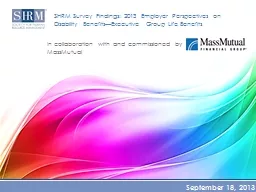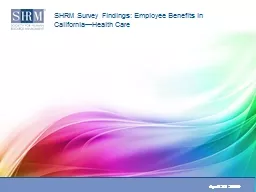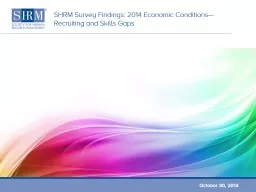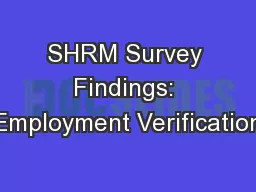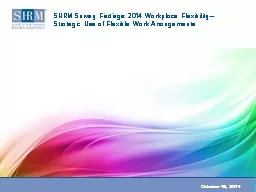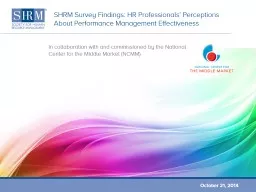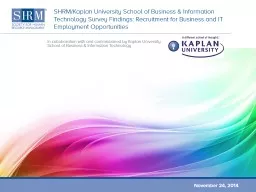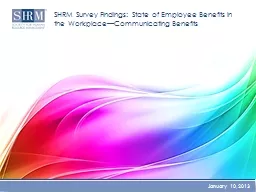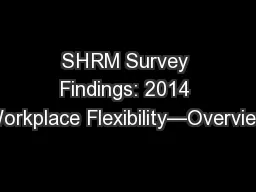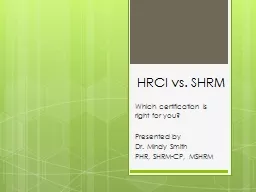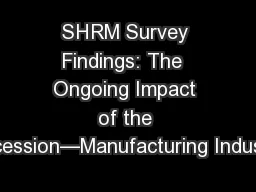PPT-SHRM Survey Findings:
Author : marina-yarberry | Published Date : 2019-11-20
SHRM Survey Findings 2013 Employer Perspectives on Disability Benefits Executive Group Life Benefits In collaboration with and commissioned by MassMutual September
Presentation Embed Code
Download Presentation
Download Presentation The PPT/PDF document "SHRM Survey Findings:" is the property of its rightful owner. Permission is granted to download and print the materials on this website for personal, non-commercial use only, and to display it on your personal computer provided you do not modify the materials and that you retain all copyright notices contained in the materials. By downloading content from our website, you accept the terms of this agreement.
SHRM Survey Findings:: Transcript
SHRM Survey Findings 2013 Employer Perspectives on Disability Benefits Executive Group Life Benefits In collaboration with and commissioned by MassMutual September 18 2013 The 2013 Employer Perspectives on Disability. on the Workplace. In collaboration with and commissioned by. November 12, 2013. What types of vacation benefits do organizations offer? . Slightly more than one-half (55%) of organizations offer paid vacation plans, whereas the remaining 45% offer paid time off plans.. April 23 . 2014. This is part . three of . a series of SHRM survey findings examining employee benefits in the . workplace of California organizations. . The . following topics are included in the six-part . Economic . Conditions—Recruiting . and Skills Gaps. October . 30, . 2014. This is Part 2 of a series of SHRM survey results . about the state of jobs and skills in the . current economic . condition, . June 16, 2014. Definitions. Employment Verification: . The process in which employees produce documents that verify their identity and eligibility to work in the United States. Part of this process is for employers to review documents and complete the Employment Eligibility Verification Form (Form I-9).. Use of Flexible Work . Arrangements. October 15, 2014. 2. Introduction and definition. Introduction. The 2014 Workplace Flexibility Survey was administered by the Society for Human Resource Management (SHRM) to identify the prevalence and types of flexible work arrangements (. About Performance Management Effectiveness. In collaboration with and commissioned by the National Center for the Middle Market (NCMM). October 21, 2014. How often do organizations conduct formal employee performance appraisals? . Technology Survey Findings: Recruitment for Business and IT Employment Opportunities. In collaboration with and commissioned by Kaplan University School of Business & Information Technology. November 24, 2014. January 10, . 2013. This is part . six . of a series of SHRM surveys examining the state of employee benefits in the workplace. . The following topics are . included in . this . six-part . series:. Part 1: Wellness initiatives . Use of Office . Pools. April 25, . 2013. Definition. In this survey, the term “office pools” refers to gambling in the workplace, including games, competitions or other events. Office pools can be linked to football games, the Super Bowl, the Oscars, the NCAA basketball championship . of Flexible Work . Arrangements. October 15, 2014. Introduction. The . 2014 Workplace Flexibility Survey was administered by the Society for Human Resource Management (SHRM) to identify the prevalence and types of . Presented by . Dr. Mindy Smith. PHR, SHRM-CP, MSHRM. History Lesson. Originally, Human Resources Certification Institute (HRCI) was the only governing body to administer exams. Now both HRCI and . Society for Human Resources Management (SHRM) . SPHR, CAE. ©. SHRM 2014 . April 2014. Information . 24/7. Education and Professional . Development. Personalized Help with HR C. hallenges. Networking. Advocacy. Recertification Credits. What . does SHRM provide to members?. SHRM Survey Findings: The Ongoing Impact of the Recession—Manufacturing Industry September 25, 2013 These are the Manufacturing industry survey findings about the ongoing impact of the U.S. and global recession, which began in 2007. SHRM Survey Findings: Workplace Romance September 24, 2013 How common is workplace romance? One out of four (24%) employees reported they have been or are currently involved in a workplace romance. Forty-three percent of HR professionals
Download Rules Of Document
"SHRM Survey Findings:"The content belongs to its owner. You may download and print it for personal use, without modification, and keep all copyright notices. By downloading, you agree to these terms.
Related Documents

